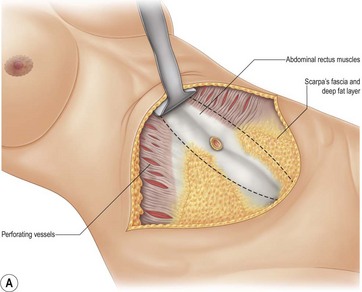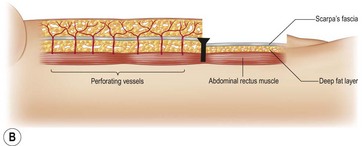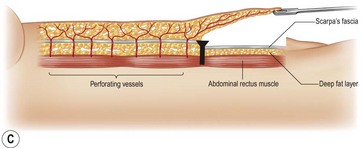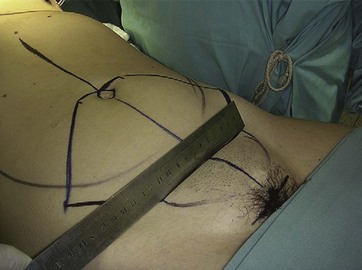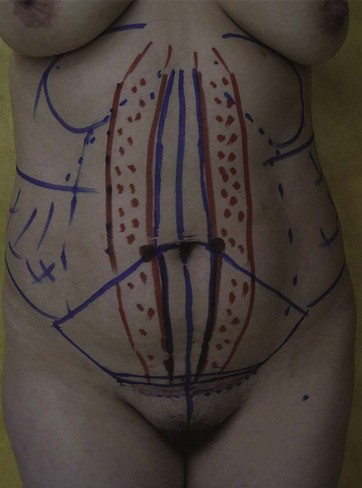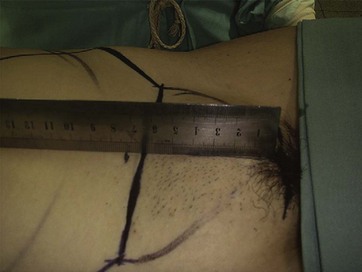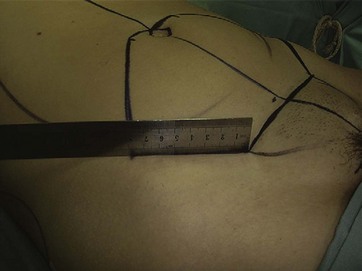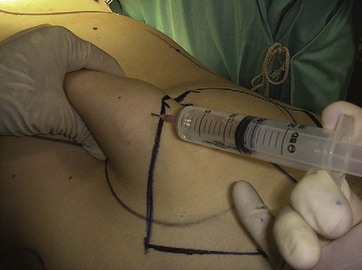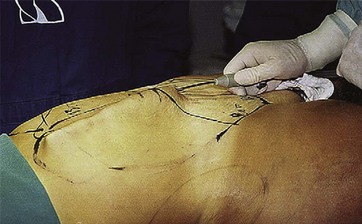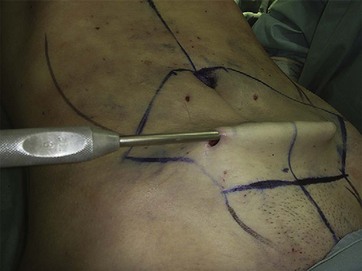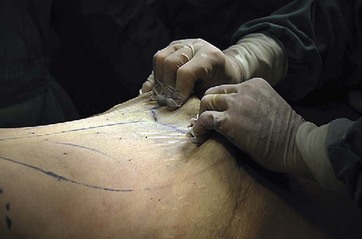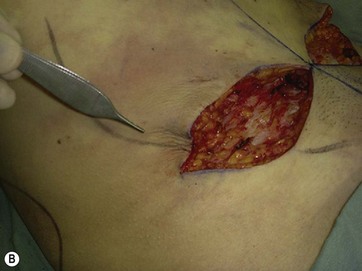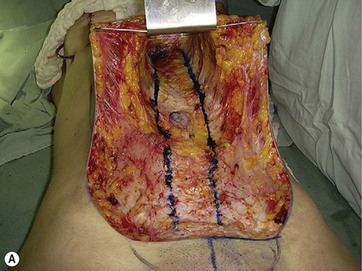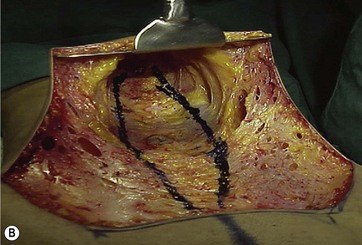Chapter 28 Lipoabdominoplasty
![]() For additional online content visit http://www.expertconsult.com
For additional online content visit http://www.expertconsult.com
A Lipoabdominoplasty
Key Points
• Lipoabdominoplasty was developed and patterned as a safe and functional option with which to perform liposuction and abdominoplasty during the same surgical procedure, promoting the benefits of both techniques.
• This technique is not simply using liposuction while we are performing abdominoplasty. It has a much wider concept, respecting the complete abdominal anatomy by performing a selective undermining and preserving the Scarpa fascia. This will be studied in this chapter.
• A technique that greatly reduces the complications of abdominoplasty by the preservation of the blood supply and drainage (perforating vessels), nerves, and lymphatic branches.
Introduction
1. Traditional and wide undermining used in abdominal plastic surgery has a high rate of morbidity.1–4
2. Plastic surgeons were not satisfied with the esthetic results and complication rates from traditional abdominal plastic surgery.
3. Surgeons have always been motivated to offer the best results with a lower complication rate. In the 1990s, many papers were published relating to the decrease in undermining and the avoidance of performing full liposuction in abdominoplasty because of increasing complications. Patient safety was our major objective when developing lipoabdominoplasty. This technique patterned the limits of abdominal flap undermining, making it safe and generating a better esthetic result. It can be learned quickly because surgeons are used to performing each procedure, liposuction and abdominoplasty, separately.
Observations
According to published evidence, the perforator vessels represent 80% of the blood supply of the abdominal wall.5,6 Consequently, the vascularity of the remaining flap is supplied by the intercostal, subcostal, and lumbar perforating branches, which are situated in the back and flank regions.7 The occurrence of ischemic processes with tissue necrosis and dehiscence of the suture has been described when abdominoplasty is associated with liposuction (this is without a selective undermining).8![]()
History
1899 to 1990s
1. 1899 to 1957, progressive undermining of the abdominal wall was performed.
2. 1957, Veron standardized the extensive undermining to facilitate umbilical transposition.9
3. 1980, Illouz developed liposuction, and from this date the combination of both techniques has always been a hot topic in the main literature, national and international meetings.10
4. 1985, Hakme and Shestak presented a new approach for abdominal lipectomies, the “Mini-abdomiplasty technique” of liposuction of the abdomen and flanks, associated with an elliptical resection of the suprapubic skin and the plication of the supra and infraumbilical muscles, without relocating the umbilicus.11,12
1990s
1. 1991 and 1995, Matarasso focused on the complications of combined liposuction and abdominoplasty, presenting two articles recommending the safe areas of liposuction. In those articles he considered the back and the flanks safe areas, did not regard the lateral region of the abdomen as a safe area, and considered the central region of the abdomen prohibited for liposuction.8
2. 1995, Lockwood reported “high lateral tension abdominoplasty” in which he used Scarpa fascia to decrease the tension of the skin closure.13
Since the 1990s, the undermining has decreased in extent because of the large number of complications (seroma, hematoma, and most of all, necrosis),14 reaching zero in 1992 with the publication of “abdominoplasty mesh undermining” by Illouz.10
4. The trend of abdominolipoplasty with or without small undermining continued up to 1999, when Shestak presented the partial abdominolipoplasty method, with no undermining, associated with liposuction.12
2000 to Present
Lipoabdominoplasty was developed by Saldanha in 2000 and first published in 2001as a safe option to correct esthetic and functional abdominal deformity while achieving better esthetic results with technical simplicity for surgeons.15 In that publication, a selective undermining between the medial borders of the rectus abdominal muscles was presented and use of the term “Lipoabdominoplasty” was standardized for the first time. Lipoabdominoplasty combines two traditional techniques, abdominoplasty and liposuction. The new and conservative concept is based on the preservation of the abdominal perforating vessels (subcutaneous pedicle), which are branches of the deep epigastric vessels.5–7 This technique conserves about 80% of the blood supply of the abdominal flap compared with traditional undermining. The lymphatic branches and nerves are preserved, maintaining the cutaneous sensitivity of the flap to superficial pain and superficial touch caused by temperature, vibration, and pressure, which is an improvement over traditional abdominoplasty.15–19
Preoperative Preparation
1. Indications: same indications as traditional abdominoplasty (skin flaccidity, fat accumulation, plus diastasis of the rectus muscle).
2. Surgeons who wish to adopt this technique should perform the lipoabdominoplasty first in patients with excessive skin flaccidity and in those who are overweight; surgeons can then develop more confidence with this procedure, which has a short learning curve.
3. Assessment of the entire abdomen must be performed, especially looking for hernias. Ventral, lumbar, and femoral hernias should be ruled out. In the authors’ practice, preoperative ultrasonography of the abdominal wall looking for hernias is routinely performed on all patients.
Anatomy
Preservation of Scarpa’s fascia and the deep fat layer partially in the lower abdomen (between the umbilicus and the pubis) allows a complete reconstruction of the abdominal wall in the lower abdomen to be performed (Fig. 28.1).
Tunnel undermining is performed exactly between the medial borders of the rectus muscles, corresponding to the diastases area, preserving at least 80% of the perforating vessels, and also preserving lymphatics and nerves. Graf et al,20 using echo Doppler, showed the flow of the periumbilical perforating vessel 15 days after the procedure, and Munhoz and colleagues,21 through a Doppler ultrasound study, found that about 80% of the perforating vessels mapped in the preoperative period were maintained. This validates the hypothesis of lesser complication rates due to flap ischemia when performing lipoabdominoplasty.
Surgical Technique
We base the technique on three main principles:
1. Superficial and deep liposuction:
The deep and mainly superficial liposuction increases the mobility of the abdominal flap, and it can descend easily to the suprapubic region.22
2. Anatomic study of the abdominal blood supply:
The study of the exact localization of the perforating abdominal vessels led us to perform a selective undermining (tunnel undermining), preserving at least 80% of the blood supply of the abdominal wall, also reducing nerve trauma and maintaining lymphatic drainage. This produces fewer complications when compared to traditional abdominoplasty, even in post-bariatric surgery.
3. Scarpa’s fascia preservation:
Although the lipoabdominoplasty may be performed removing Scarpa’s fascia, its maintenance is one of the most important steps of the technique.
Marking
1. Mark the initial incision line (Fig. 28.2 and 28.4).
2. Mark the areas to be liposuctioned (Fig. 28.5).
Observations on this Step
Point A: 7 cm from the vulva commissure (Fig. 28.3).
Points B and C: 14 cm horizontal parallel line divided by point A. Point B: right side of the patient, Point C: left side of the patient.
Point D: 7 cm from point B in the direction of the patient’s right iliac crest.
Point E: 7 cm from point C in the direction of the patient’s left iliac crest.
In summary, the distance between the points:
Infiltration
1. Tumescent technique (Fig. 28.6).
2. 1 : 500 000 saline solution with epinephrine (adrenaline) in the abdominal region (average of 1 to 1.5 l) (Fig. 28.6).
Upper Abdominal Liposuction
1. The patient is placed in a hyperextended position on the surgical table (safer position).
2. Liposuction of the deep and superficial layers of the upper abdomen using 3 and 4 mm cannulas is carried out.
3. Extend liposuction to the flanks as the lateral limits and up to the submammary fold as the upper limit (Fig. 28.7).
Lower Abdominal Liposuction
1. Entire liposuction of the superficial fat layer in the lower abdomen is carried out with a 6 mm cannula (Fig. 28.8).
2. Partial liposuction of the deep fat layer in the lower abdomen is done with a 4 mm cannula.
3. Assessment of the descent and mobility of the abdominal flap (Fig. 28.9). (If safe, the next step can be performed – “incision”.)
Incision and Undermining in the Lower Abdomen
1. The incision is made in the previously marked area.
2. The flap is undermined above Scarpa’s fascia.
Scarpa’s Fascia Preservation
The preservation of Scarpa’s fascia is important for many reasons (Fig. 28.11A).
1. There is less bleeding and less seroma because of the preservation of the inferior perforating vessels and the preservation of the lymphatic branches. This leads to less morbidity.
2. It creates a homogeneous support and better adherence between the upper flap and the deep layers.
3. It causes the contention of the scars laterally (Fig. 28.11B).
Selective Undermining (Tunnel Undermining)
1. Undermining is performed in the midline of the upper abdomen, between the internal edges of the rectus abdominal muscles (Figs 28.12 and 28.13). Neglecting to limit the dissection in this manner may result in damage to perforating vessels, which increases morbidity and the risk of abdominal flap necrosis.
2. Tunnel undermining may reach the xiphoid, depending on the need for rectus muscle plication.
3. The tunnel width may vary with the distance of diastasis because the perforating vessels follow the muscle separation.
• Better visualization of the tunnel and the anatomic structures.
• Easier plication of the rectus muscle.
Stay updated, free articles. Join our Telegram channel

Full access? Get Clinical Tree


